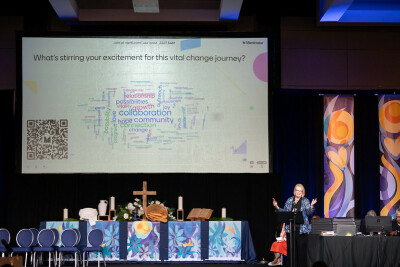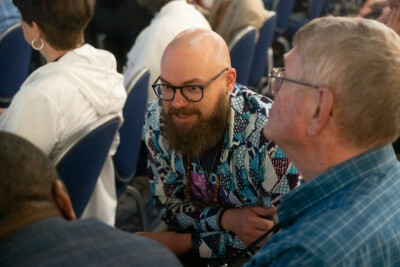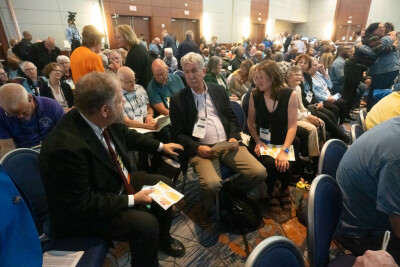BWC enters into 'historic' new structure
Clergy and lay members from the 563 churches of the Baltimore-Washington Conference sounded the first notes of the conference’s new song and structure when the 64 hubs and six new districts gathered in the ballroom of the Hilton Hotel in Baltimore on May 13.
As a small band of jazz musicians improvised, church leaders explored the similarities between jazz music and vital ministry.
“One instrument, like one congregation alone, is beautiful – pure clear, expressive,” explained the Rev. Michael Parker. But when others join in – when each musician listens and responds – something even more powerful emerges, he said. “The sacred song goes deeper, sounds richer, is more alive.”
 As the hubs begin their ministry July 1, churches are being called to move into this metaphor as they “listen deeply and pay attention to the needs around them,” Parker said. “They will collaborate fearlessly, trusting and sharing across lines of difference, and improvise faithfully, letting new ideas, gifts, and ministries merge from the Spirit’s movement.”
As the hubs begin their ministry July 1, churches are being called to move into this metaphor as they “listen deeply and pay attention to the needs around them,” Parker said. “They will collaborate fearlessly, trusting and sharing across lines of difference, and improvise faithfully, letting new ideas, gifts, and ministries merge from the Spirit’s movement.”
The new structure is designed to provide resources to churches as they grow in vitality and pursue the denomination’s vision to “love boldly, serve joyfully and lead courageously.
But “new ministry doesn’t always come from following old maps,” said Christie Latona, the BWC’s Director of Connectional Ministries. She, and several other local church leaders, shared the importance of first creating meaningful relationships with other churches and the community.
“Building relationships is at the heart of it all,” Latona said. From the stage, people in local churches shared stories of their successful ministries and, in the audience, people took time to introduce themselves to the members of their new hubs.
Once relationships are formed, ideas for meaningful ministry can be discerned, Latona said. Within the BWC, churches are creating vitality through Missional Action Planning, or MAP.
MAP seeks to creatively and strategically bring a church’s gifts and resources into ministry in the community.
 There are five key steps that BWC churches are using to pursue Missional Action Planning (MAP). They include:
There are five key steps that BWC churches are using to pursue Missional Action Planning (MAP). They include:
- Discover the strengths of the congregation and the needs of the community;
- Discern how God might be calling you and your church;
- Engage a God-fueled imagination;
- Define and create a ministry; and
- Implement the new ministry, tending it as it evolves.
Within the BWC, MAP and the new structure are anchored in five key values: love in action, unity in diversity, strength through connection, partnering with purpose and the freedom to try.
Noting that the start of this new structure represents “a sacred time in the history of the Baltimore-Washington Conference,” Bishop LaTrelle Easterling offered a blessing.
“Standing on the threshold,” she said as she called on living water – “the water that danced at creation” -- to speak life into the hubs and new districts, “running deeper than discouragement, deeper than doubt and deeper than the lies whispered by fear.”
The bishop blessed each member’s hands to build, their feet to go into the world, and their hearts to burn with holy fire for the glory of God and the healing of the world.
 Then, led by the superintendents of the six new districts, the members joined together, praying:
Then, led by the superintendents of the six new districts, the members joined together, praying:
May the rhythm of grace guide our next steps.
May we listen well.
May we play boldly,
And may what we create together be nothing short of transformational.
Learn more about the new structure.
Learn more about Missional Action Planning.
